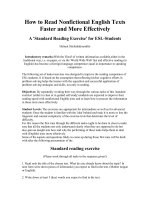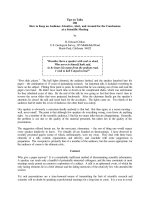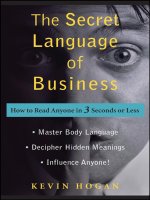How to Read Nonfictional English Texts Faster and More Effectively
Bạn đang xem bản rút gọn của tài liệu. Xem và tải ngay bản đầy đủ của tài liệu tại đây (84.52 KB, 5 trang )
How to Read Nonfictional English Texts
Faster and More Effectively
A 'Standard Reading Exercise' for ESL-Students
Helmut Stiefenhöfer
Introductory remarks:With the 'flood' of written information available,either in the
traditional way, i.e. on paper, or via the 'World Wide Web' fast and effective reading (in
English) has become a (foreign) language competence equal in importance to speaking
competence.
The following set of tasks/exercises was designed to improve the reading competence of
ESL-students. It is based on the assumption that reflecting his/her cognitive efforts in
problem-solving helps the learner with the aquisition and successful application of
problem-solving strategies and skills, not only in reading.
Objectives: By repeatedly working their way through the various tasks of this 'standard
exercise' (either in class or in guided self-study) students are expected to improve their
reading speed with nonfictional English texts and to learn how to process the information
in those texts more effectively.
Student Levels: The exercises are appropriate for intermediate as well as for advanced
students. Once the student is familiar with the 'idea' behind each task it is more or less the
linguistic and content complexity of the exercise-texts that determine the level of difficulty.
For this reason the first runs through the different tasks ought to be done in class to make
sure that all the students not only understand clearly what they are supposed to do but also
gain an insight into how and why the performing of these tasks helps them to deal with
(English) texts more effectively.
Some of the aspects and questions likely to come up during those first runs will be dealt
with after the following presentation of the
Standard reading exercise
(Please work through all tasks in the sequence given!)
1. Read only the title of the chosen text. What do you already know about the topic? In note
form write down pieces of information you expect to find in the text. (Mother tongue or
English).
2. Write down at least 5 (key) words you expect to find in the text.
3. Is the text
a) an extract from a book? ......
b) a newspaper article? ......
c) a magazine article? ......
d) a scientific article? ......
e) a................................................
(tick the right answer)
4. When was it published?..................
5. Read through the whole text as quickly as possible. Don't worry about the words you
don't understand. Now write down, in not more than 15 words, the main theme of the text.
6. Ask yourself if the text may suit the needs that made you choose it as a source of
information.
7. Read through the text again trying to understand as much as you can. When you come
across a word which you don't know and which you think is important for the text write it
down and beside it write your idea of what it probably means. (Mother tongue or English).
Use the dictionary only if absolutely necessary!
8. Divide the text into sections. Name the sections according to their function (e.g.
introduction, main part(s), conclusion etc.) and give one content-related keyword for each.
9. Write down the main idea of each paragraph using one sentence only.
10. Draw a diagram or a flowchart to show how the information in the text is organized.
11. Which of the expectations/anticipations you listed in task 1. does the text meet?
a) ..... b) ..... c) ..... d) ..... e) .....
12: On a separate sheet write a summary of the text. Not more than 100 words! Make use
of the results of tasks 8, 9, and 10.
13: What do you think of the text? Evaluate it in the light of your reading purpose. Give
reasons for your evaluation.
Task 1: Here the student is expected to activate the knowledge he/she already has about
the text's topic area. To do so helps him/her a) to to review the choice of this specific text
for his/her specific reading purpose (cf. also task 6), and b) to focus his/her attention and
expectations on a certain direction which narrows the content-range of the decoding
decisions in the text-processing to follow.
Task 2: Where task 1 aims at the content level of the text to be dealt with task 2 makes the
reader activate his/her linguistic knowledge and focus on topic-related lexical and to some
extent syntactic registers.
Task 3: Identifying the type of text helps the reader to get an idea about the addressees the
author had in mind and about the likely 'depth', accuracy, and 'seriousness' of the text.
Task 4: To know the publication date of a text influences the expectations towards its
topicality. A text on software-engineering written in the 1980's obviously cannot contain
today's knowledge in this field.
The key-concept underlying tasks 1 - 4 is the assumption that the processing of the content-
and linguistic items of a text is facilitated considerably if the reader has activated the
knowledge he/she already has about those and/or related items to a state of alert. The less
you are surprised by what you learn the faster you can 'place it in the right drawer in your
knowledge-store'. Such anticipatory activities are probably the most important ones in
effective learning through reading. When a student has dealt with tasks 1 - 4 a few times ,
has grasped the underlying concepts , and has overcome the common urge to start reading a
text closely right away it doesn't take him/her longer than a couple of minutes to work
through these tasks.
Task 5: Dealing with this task requires competence in the reading strategy called
"skimming" which can and ought to be developed in other units of EFL-courses and can be
applied and practised here.
At this stage of the 'Standard Reading Exercise' the student has his/her first chance to to
check if his/her educated guesses and expectations about the text at hand have been in the
right direction.
Task 6: The results of task 5 can be used as the basis for answers to questions like: Is this
the subject matter I expected the text to be about? Is it likely that in close reading this text
will meet my reading purpose and suit my information needs? etc. Questions like these are
relevant for an economical approach to the above mentioned 'flood' of information not only
in study situations.
Task 7: Once a student has internalized the cognitive operations needed to perform tasks 1
- 6 successfully in 'real life reading situations' it will very much depend on the answers
he/she gives in task 6 wether he/she attacks task 7. In reading-practise situations within
ESL-lessons the importance of such decisions ought to be made aware to the
students,however, in the interest of the practise effects of this and later tasks they should
remain hypothetical.
Here, with task 7, the reader must apply processing skills he/she has aquired and practised
before. Amongst those are "making use of inter-language similarities", "morphologically
based word-analysis", "guessing from context", "effective dictionary usage", "looking for
text-type typical syntactic schemes", etc..
Task 8: Identifying the basic structure of a text and its major parts with their functions and
their main 'message' helps the reader with a first step of organizing the bits and pieces of
information he/she has gained through the previous tasks.
Task 9: Here the reader is asked to reconstruct the more or less obvious links between the
pieces of information found in a paragraph (so called propositions) by making use of their
linguistic representation (e.g. reference words) and to combine their major elements to
information units at a higher, i.e. more general and abstract level (so called
macropropositions).
It helps the student if his/her special attention in the first encounters with this task is
directed towards the beginning and the concluding sentence of paragraphs, especially
longer ones.
Task 10: Dealing successfully with this task requires a basic concept of how information
elements in a text are combined by an author to build the text's structure. It also requires the
awareness that being able to reconstruct this structure and to visualize it is very helpful if
the reader wants to a) check his/her understanding of the text, b) put down the so gained
knowledge in a visually clear way that makes it fairly easy at a later time to refresh or to
reactivate this knowledge, e.g. for exam-preparation.
With the teaching of the basics of diagram- and flowchart-visualizing (e.g. tree-diagram vs.
chronological chart) the English teacher can either (hopefully) draw on what has been
taught in other classes (natural or social science) or has to lay this foundation him-/herself.
Task 11: The main function of this task is pedagogical. In my experience it is motivating
for the student to see again and this time more clearly, that he/she not only has anticipated
correctly but also that he/she had already known a lot about the topic at hand.
In 'real life reading' this step can be skipped when processing a text, especially since task 6
serves a very similar purpose.
Task 12: With this task the reader is asked to deal with the 'products' of his/her text-
processing in a way that a) allows him/her to check his/her comprehension while
summarizing the text's content in writing, preferably in his/her own words, b) owing to the
100 words limit, forces him/her to concentrate on the essentials of the text, c) leads to a
product which can be used for exam-preparation (cf. task 10), and d) last but not least, is a
realistic/authentic writing exercise/task.
As far as a) - c) are concerned task 9 requires very similar cognitive activities and may
suffice for mere 'reading in study situations'. The additional writing practise, however, has
its own merits that don't need to be outlined here.
Task 13: Here the student is asked to reflect on the information gained with reference to
his/her reading purpose and to view it critically to see whether and if so how far it fits into
his/her previous knowledge structure about this topic. The latter might lead to a) adding
this information to his/her topic-knowledge, b) questioning it and looking for further
confirmation or refutation, or c) to directly rejecting what the author said.
The self-confidence necessary for decisions as in b) and especially c) has to be developed
in the classroom through repeated encouragement towards taking nothing for granted only
because it exists in print and trusting one's judgement if there is sound proof of its validity.
Such self-confidence together with competence in critical evaluation will become more and
more important. Especially since the WWW, as a result of its principles, is fed with a huge
quantity of texts the usefulness of which is highly debatable.
Concluding remarks: What has been said about the individual tasks and the concepts
behind them certainly doesn't cover all the explanations and all the elements of assistance a
student needs when confronted with this 'Standard Reading Exercise' especially the first
few times.
Hopefully, however, it has made clear that there are ways of 'breaking down' something as
complex as 'effective reading competence' into manageable teaching- and practise units.
Our experience in the classroom with this set of tasks/exercises has been positive.
Nevertheless, we are of course open to criticism and look forward to learning about the
experience made by colleagues facing the difficult task of teaching reading in ESL
classrooms.









